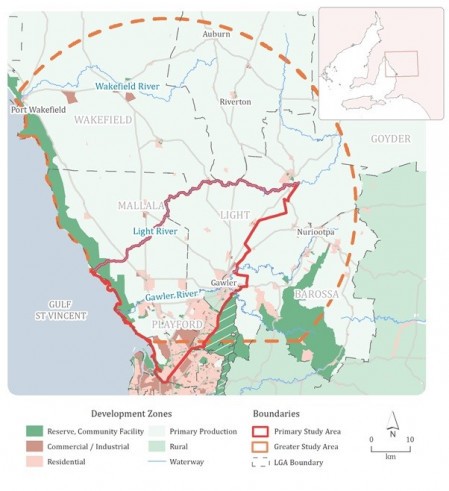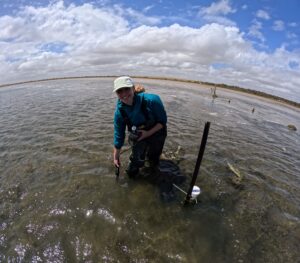
Production in one of South Australia’s most important food bowls could double if irrigated agriculture and horticulture expands across the Northern Adelaide Plains (NAP) – the area north of Adelaide between St Vincent Gulf and the Mt Lofty Ranges. Horticulture on the NAP generates more than a fifth of South Australia’s fruit and vegetables – approximately 204,000 tonnes of fresh produce each year – worth more than $313 million (a third of the state total 2016-17). The potential expansion is underpinned by the Northern Adelaide Irrigation Scheme.
The Goyder Institute report Sustainable expansion of irrigated agriculture and horticulture in Northern Adelaide Corridor released this week summarises research undertaken over the last two and a half years to make sure the proposed expansion would be sustainable into the future within the NAP. The findings of this research are also applicable to irrigation development across the larger Northern Adelaide Corridor – the area between Adelaide and Whyalla. The research team, from PIRSA-SARDI, CSIRO, UniSA, Flinders University and The University of Adelaide, identified the risks associated with long-term irrigation in the region and addressed the knowledge gaps required to assess these risks and, if necessary, mitigate them.
Water availability has been a significant barrier to economic development but a stocktake by the Goyder Institute for Water Research in 2016 found an additional 26 GL/year that could support the area’s expansion. It’s estimated that this will allow an additional 3000 hectares to be put under irrigated cropping, increasing gross regional product by about $500 million each year.

Much of the water underpinning the expansion will be recycled water from the Bolivar Wastewater Treatment Plant (12 GL/year), which is on track for first water to be available from late 2019 through the Northern Adelaide Irrigation Scheme, an initiative of the South Australian and Australian governments.
Experiences from elsewhere suggests there are some challenges with using recycled water to increase agricultural production. Although its use has been proven on the NAP, this experience provides invaluable guidance on management strategies that can be applied for sustainable development of irrigated agriculture.
In response, the research team:
- identified the risks to native soil types and developed guidelines for the sustainable use of recycled water based on soil attributes and impact assessments (including a gypsum amendment model)
- assessed the depth to groundwater across the region (shallow, often saline, groundwater can be affected by increased recharge through irrigation) using a range of innovative techniques, as well as aquifer storage and recovery options
- developed a model that predicts the path of nutrients and chemicals through the soil and identified mitigation strategies under current and future climates
- identified multiple complementary water sources available to support irrigation and mitigate risks
- developed a tool (IW–QC2) to help growers make better decisions around water resource selection, desalination requirements, storage and water quality
- recommended a regional monitoring program to assess the broader implications of water management and make sure that all environments – crop, soil, groundwater, surface water – are protected into the future.
Long-term modelling scenarios were conducted in four main NAP soil groups using a range of water sources, open field (almonds, viticulture, pistachios, pastures, carrot, onion and potato) and greenhouse (tomato, cucumber, capsicum and eggplant) crops, and management scenarios. Irrigation requirements in the region are expected to rise by 3-11% in the near future as the climate changes. The report identifies additional water sources, such as seasonally available roof run-off, that could increase the amount of water available and reduce salt loads by at least 23% when used in conjunction with recycled water. The modelling also identified that management of salinity and sodicity hazards in the soil will be important to ensure the long-term productivity of the region, with gypsum application and leaching identified as being important mitigation techniques.
As a result of the Sustainable expansion of irrigated agriculture and horticulture in Northern Adelaide Corridor project, horticultural producers and water managers are now better able to make decisions on how recycled water can be used in a sustainable way to increase production and improve economic returns over the long term.
The summary report is underpinned by a suite of detailed technical reports including:
- Development and optimisation of modelling domain and impact assessment of irrigation expansion on the receiving environment.
- Modelling nutrient and chemical fate, including salinity/sodicity risk, as the basis for identifying longevity of recycled water utilisation and mitigation strategies under current and future climate.
- Source water options/water availability, quality and storage consideration.
- Assessment of depth to groundwater (proof of concept).
Contact project leader Professor Jim Cox (PIRSA–SARDI) for more information about the research or Goyder Institute Director Dr Kane Aldridge for more information on the Institute’s Economic Development projects.


